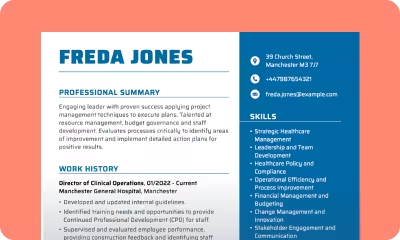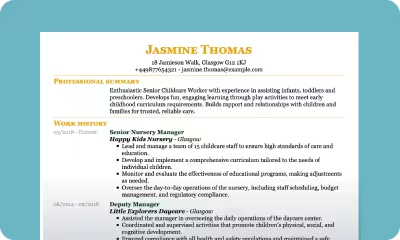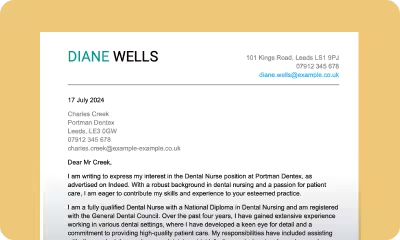- Our customers have been hired by : *Foot Note
QA and testing professionals understand that a quality CV is vital to a successful job search. Candidates applying for a manual QA tester position will have the best chances of securing their ideal job with a well-written CV. It should be adapted to the job and include their most impressive qualifications, accomplishments, and relevant skills.
Before finalising and sending off a CV, we recommend looking at this manual QA tester CV sample to obtain an idea of the required formatting and information. The manual QA tester sample set out below is a CV example of a very effective and well-organised document that should attract the attention of the hiring manager(s) or recruiter and win an interview.
Want to make a splash in the sea of equally experienced candidates? We suggest choosing a pre-made CV template to showcase your top talents and experience. Pick a professional design, complete each section using the expert tips below, and save the document as a Word or PDF file. We’ve streamlined the process from start to finish, so you don’t have to worry about the fiddly bits.
Interested in learning more? The following sections cover:
SEARCH ALL CV EXAMPLES
Sample manual tester CV
Joanna Dylan
246A Lawrence Drive
Bradford BD7 4PP
07912345678
Joanna.Dylan@example-example.co.uk
Professional summary
Practical, highly skilled individual demonstrating out-of-the-box thinking. Optimises cost-effective operations and improves safety by scrutinising existing practices. Proven success fulfilling complex project briefs on-time and under budget.
Work history
March 2021 – Current
American Express – Bradford
Manual Tester
- Facilitated effective decision-making by proactively participating in daily scrum stand-ups.
- Delivered high-quality Python and Java code, compliant with internal coding standards.
- Maximised ROI by evaluating and modifying tests for improved effectiveness.
- Used risk-based testing approach to determine test automation strategy based on risk scenarios.
February 2020 – February 2021
American Express – Bradford
Test Analyst (trainee)
- Planned and executed testing strategy for data analysis and synchronisation.
- Implemented Agile development methodologies.
- Identified and fixed potential risks and flaws for smooth running of system.
- Actively improved testing methods and strategies to meet increasingly defined requirements.
Skills
- Data gathering and review
- Protocol development
- Compliance monitoring
- Testing plans
- Root Cause Analysis
- SQL proficiency
Education
2019
Bradford College Bradford
SQL Essentials
2018
Bradford College Bradford
A-levels: Computer Science (A), Business Studies (B), and English (B)
Which format is right on a CV for manual tester applicants?
While you might be eager to jump straight into CV writing, the first step is choosing between popular CV formats. These professional templates present your experience, achievements, skills, and qualifications in the best possible light.
Busy hiring managers prefer easy-to-read and well-structured applications because they show extra care. Plus, many organisations use CV reading software that relies on clear headings, sections, and fonts. If you don’t take the time to format your application correctly, why should decision-makers waste theirs on giving you a chance?
There are two widely accepted blueprints to choose from – the reverse-chronological CV and the skills-based CV. The former runs through your work history, starting from your current or most recent role. You can talk about apprenticeships, temporary contracts, and part-time positions alongside full-time employment. The latter emphasises transferable skills, like “IT literacy”, “administration”, and “communication”.
Both are valid, but the reverse-chronological CV is the best choice for manual testers. Employers prioritise applicants with tangible experience, preferably in a similar industry. The skills-based CV is only suitable for candidates with no relevant career background, such as school leavers or those re-entering the workforce after a long break.
Now you’ve settled on a structure, here are some other tips to keep in mind:
- Your CV should only be one to two pages long maximum
- Type in a legible font, like “Times New Roman”, “Calibri”, or “Arial”
- Use bullet point lists to separate large chunks of text
- Avoid colours and images – they make the page look busy
- Send your application as a Word or PDF file unless sked otherwise
How to write a CV for a manual tester
You’re in the right place if you want to learn how to write a CV that’ll blow the competition away. The following sections explain everything you need to know about CV writing – paired with answers to some of your most frequently asked questions. Take your time to craft your application so you don’t skip over crucial details. Let’s explore:
- What contact details should I include in my manual tester CV
- Start your manual tester CV with a personal statement
- How to present your work history on a manual tester CV
- Top skills for your manual tester CV
- How to add education to your manual tester CV
What contact details should I include in my manual tester CV
Before tackling the lengthier sections, you must add your most current contact details at the top of your manual tester CV, ideally in a slightly larger and bolder font to make them stand out. Why is this essential? Employers can’t invite you to the interview stage if you’re a nameless and informationless candidate! Remember to include:
- Full name
- Location
- Phone number – the best one to reach you on
- Email address – keep it work appropriate
Example of contact section for a manual tester CV
Philip Jennings
122 Seaview Road,
Brighton,
East Sussex, BM29 5SH
01203 456789,
pjennings@example.com
Start your manual tester CV with a personal statement
Recruiters receive hundreds of CVs, especially for manual testing because it’s highly competitive. So, how do you cement yourself as the best candidate? The secret is a persuasive personal statement summarising your most desirable qualities and accomplishments. However, there’s a catch – you only have three to four short sentences to get your point across.
Luckily, we have a handy formula to help. Open by explaining who you are, including your career focus and years of experience. Next, drop in a statistic that differentiates you as an expert in your field. For instance, you might have “implemented a brand-new testing strategy that boosted productivity by 93%”. Lastly, reiterate your unique capabilities and specialisms, such as “knowledge of financial software”.
Above all else, don’t go over the word count. We know you want to wow the hiring manager, but waffle isn’t the way forward! Here are some extra tips to inform the writing process:
- Use the third person to sound more professional
- Include plenty of positive adjectives to uplift the tone, like “passionate”, “dedicated”, and “confident”
- Keep the information relevant to the job advertisement
- Don’t lie or embellish – employers can sniff out inauthenticity
- Provide evidence of skills and experience using numbers
Example of personal statement for a manual tester CV
A passionate manual tester with over 12 years of experience in financial services. Confident in reporting and documenting technical bugs. Spearheaded a team of QA testers that improved over 100 computer software applications. Excellent communicator who works closely with developers, project managers, and product managers to guarantee quality.
OR
A trained, qualified, and motivated test analyst with over five years of experience. Has a solid grounding in a financial services environment. Currently seeking an opportunity to develop further and widen QA testing, business experience, and analysis skills in a progressive team with a major employer.
How to present your work history on a manual tester CV
Employers love to sink their teeth into the work history section because there are so many delicious titbits on offer, from how long a candidate typically stays with an organisation to whether they’ve received any promotions or workplace awards. On top of this, it’s a chance to underscore your key strengths and explain all the fantastic things you can bring to the table.
Generally, you should include between three to six responsibilities underneath each role – more for newer or relevant positions. Other information includes:
- Job title
- Employment start and end dates
- Company name
- Company location
- Brief list of duties
- Career achievements
Like the personal statement, it’s paramount to play your best hand. As such, qualify as many responsibilities as possible with a tangible result or example. Let’s say you “completed various types of test” – can you be more specific and mention the outcomes? If you “investigated technical issues”, how many did you successfully solve? The more details you can provide, the better. Otherwise, it’s all hot air!
Next, avoid too much repetition. If you’ve discussed “troubleshooting software” underneath one job, talk about “test script creation” in another. Covering different responsibilities shows the employer the breadth of your capabilities. Multitalented candidates are worth their weight in gold.
There’s nothing worse than a robotic manual tester CV that put the hiring manager to sleep. To combat drowsiness, keep the tone upbeat with positive adjectives and action verbs. The latter are especially engaging and convey confidence – some of our favourites include “programmed”, “engineered”, and “proposed”.
Example of work experience for a manual tester CV
Manual Tester | American Express, Brighton (January 2020 to date)
- Assisting senior analysts with test planning and design.
- Test execution, with recording and analysis of results.
- Completing various types of tests and departmental documentation following company and team policy.
- Providing UAT to internal clients when required, as directed or under the supervision of the team leader.
Trainee test analyst | American Express (September 2019 to December 2020)
- Attended in-company and external courses, working with a team coach.
- Manual testing of financial data/system changes in a team with senior analysts.
- Entered test cases and updated results in HP Quality Centre.
- Data input, in-house matrix reports, and charts (principally defect analysis).
Top skills for your manual tester CV
While you should pepper every section with your top talents, it’s helpful to have a dedicated area for your best CV skills. Here, you summarise your most sought-after qualities to reassure the employer that you’re the right person for the job. We suggest listing around 12 skills in total, split equally between hard skills and soft skills.
So, what’s the difference? Hard skills are often learnt on the job or via formal training, and they’re specific to manual testing – think “defect creation”, “reporting bugs”, and “analysing system specifications”. In contrast, soft skills are transferable or character-based – you might be “goal-oriented”, “adaptable”, and “quick-thinking”.
You can’t include one without the other because hiring managers prefer well-rounded candidates with the right knowledge and personality. Need some more inspiration? Read through the following lists:
Essential skills for a manual tester
- Excellent eye for detail
- Team worker with commercial awareness
- Manual and functional testing, with an appreciation of automation
- SQL programming & database queries
- Familiarity with the latest testing frameworks
Desirable aptitudes to set you apart
- Full driving licence
- Excellent communication skills
- Highly organised
- Mathematical mind and problem-solving aptitude
- Good team player
How to add education to your manual tester CV
Education can cinch you the top spot if you’re battling against other outstanding candidates. It’s the foundation for your career history, opening up another world of exciting opportunities. You can discuss extracurricular courses and certificates alongside school, college, and university qualifications.
What does it take to become a manual tester? Most analysts complete a degree in Software Engineering. However, you could swap this for a qualification in your chosen field, such as “Finance” or “Computer Science”. As you’ll require a goldmine of information to get your foot in the door, we suggest combining your studies with an internship. Search for entry-level testing positions or placements to bolster your chances.
Some businesses also require candidates to have at least one Software Quality Assurance Certification. Some of the most popular options include the “Certified Test Engineer (CSTE)”, “Certified Software Quality Analyst (CSQA)”, and “Certified Associate in Software Testing (CAST)”. Read the job advertisement carefully to see whether you’ll need additional training.
When summarising your qualifications, include:
- Name of school, college, university, or other awarding body
- Study start and end dates
- Subject title
- Qualification level – such as Bachelor’s degree or A level
- Qualification result
Example of education for a manual tester CV
ABC College, London (November 2010 – November 2011)
SQL Essentials
American Express, London (October 2010 – October 2011)
In-house training courses: Excel macros and bespoke IT systems
Worthing College (September 2008 – September 2010)
A-levels: Computer Science (A), Business Studies (B), and English (B)
Durrington High School, Worthing (September 2003 – September 2008)
Seven GCSE passes, four at grade A, including ICT
Manual tester CV dos and don’ts
The best applications come with a thoughtful cover letter. This one-page document introduces who you are, recaps your most irresistible skills and achievements, and expresses enthusiasm. Our top advice? Keep the tone professional but friendly – you’re aiming to break the ice before diving into the nitty-gritty details!
Industries that build software need manual testers. Some of the most popular recruiters are within the ecommerce, manufacturing, and pharmaceutical sectors. Mention your areas of expertise in your cover letter or personal statement so recruiters can guide your CV to the right people.
Although it’s tempting to emphasise technical knowledge, don’t forget about your soft skills. Who wants the best manual tester in the world if they’re impossible to work with? Let your personality shine so the employer can assess whether you’d mesh well with the team and organisation.
Manual testers need excellent attention to detail, so it wouldn’t look good to have a CV riddled with errors! Run your application through a free spell-checker and ask a loved one to give you some feedback – a fresh pair of eyes can pick out not-so-obvious mistakes.
Your manual tester CV questions answered
What are the roles and responsibilities of a manual tester?
Every day looks different as a manual tester. There are plenty of finicky tasks to get stuck into – not to mention opportunities to share ideas and improve processes. If you want to be on the frontline of a company’s success, it’s the perfect position for you. Key responsibilities include:
- General day-to-day tech support
- Software and application testing
- Reviewing and streamlining processes
- Test progress reporting
- Providing feedback to development teams
What are manual tester skills?
Unsurprisingly, manual testers need exceptional attention to detail to identify bugs and errors. Additionally, a keen understanding of user experience helps – when offering feedback, it’s crucial to put yourself in the customer’s shoes. Recruiters look for the following skills:
- Time management
- Communication and collaboration skills
- Knowledge of test management software
- Understanding of best practices
- Natural problem-solver
Is manual testing easy for beginners?
Nothing is easy to begin with, including manual testing. Plus, the most successful individuals never get complacent and tackle challenging tasks head-on. If you’re new to the industry, we suggest searching for entry-level positions or internships to support your professional development. Alternatively, complete a college or university course to give yourself the best possible chance.
How much do manual testers earn?
It’s impossible to say how much a manual tester earns because it depends on various factors, such as location, experience, and company size. However, the average salary in the UK is around £35,000. Senior testers can earn between £65,000 and £80,000.
Related Manufacturing CV
Take the manual labour out of your manual tester CV
This manual QA tester CV sample is only one of several CV examples that provide help and support with the CV writing process. In addition, job seekers are invited to use the career tools and curriculum vitae builder on this site for additional valuable guidance.
There, you’ll find a choice of CV templates to get you started on the right foot, along with a selection of pre-written content to make it much easier to create your manual tester CV.
*The names and logos of the companies referred to above are all trademarks of their respective holders. Unless specifically stated otherwise, such references are not intended to imply any affiliation or association with myperfectCV.




